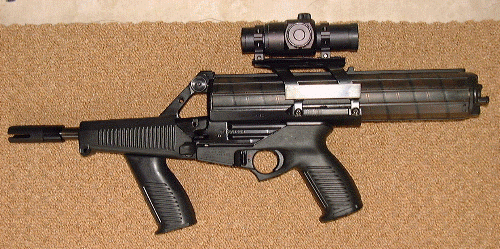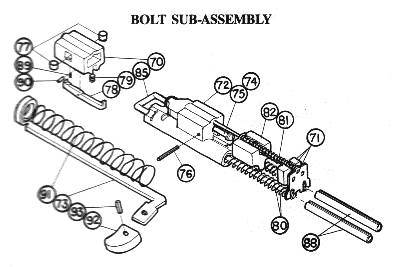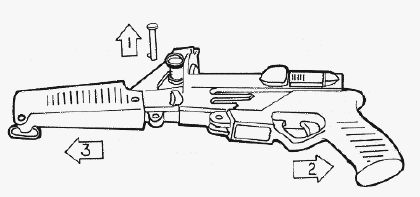
The Calico M-950 Pistol

This probably rates as one of the weirdest weapons ever produced. Few other weapons can incorporate such a huge magazine capacity into such a compact design. The weapon is interesting for many reasons which will be discussed later. However, they way it has been deactivated is perhaps as interesting and not in a very positive way. The M-950 is a pistol! Yes it is a very large pistol with a high capacity magazine, but it is very definitely classed as a pistol. The M-960 variant looks very similar to the M-950, but does give selective fire; in other words, it is classed as a machine pistol. If an M-960 was sent to the UK proof houses as a deac, you would expect it to be fully welded up in line with current regulations. However, UK law does not require semi auto pistols to be welded up (at present anyway) and therefore the M-950 discussed here should be strippable and have 'fully' moving parts. This is NOT the case. The Birmingham Proof House refused to proof the gun as a deac unless the bolt was welded to the barrel and the trigger mechanism was welded solid (including welding the safety to prevent removal of the trigger group). The reasoning behind this was apparently the fact that such a blowback weapon could more easily be converted (reactivated) to full auto mode. I thought this might signal a definite change in attitude by the proof houses to similar weapons. However, I know for a fact that the London Proof House has recently passed a Steyr SSP with fully moving parts. This is the semi auto version of the Steyr TMP machine pistol; almost exactly the same situation, but with a different outcome. I can only conclude that the Birmingham Proof House was just being very difficult and for no particular reason.
So, the M-950 is a new spec deac. However, it can still be stripped back to reasonable extent and the cocking handle can be cycled with movement of the rear bolt section (more on this later). The magazines have not been 'deactivated' to any extent and are probably as interesting as the gun! (On new spec guns, magazines sometimes have their springs removed and even magazine lips ground back.) The weapon came with a 50 round mag, 100 round mag, scope mount, vertical foregrip, and magazine loader (quite a piece of engineering on its own). This particular weapon had also been customised to include a wirestock (similar to the grease gun type); this was also included in the price paid.
Specific features of the Calico according to the manufacturer are:
50 or 100 round magazines (have I mentioned that already?)
Superior handling due to the fact that the backstrap of the pistol is much higher than other guns, directly behind the bolt rather than under it - almost eliminating muzzle climb
Ejection of spent cases downwards making it a truly ambidextrous weapon
Relatively light in weight (despite its capacity) due to the minimum mass retarded blowback bolt system and significant use of alloys and plastics in the receiver and furniture
I'm not sure that I believe the claims about weight. The weapon is heavy with just an empty magazine. However, the balance is very good even without use of the forward vertical grip.
The magazine is complex to say the least and probably quite unique. It has more parts than conventional column-type magazines and has to be properly maintained and serviced for it to function effectively and consistently. It also has the disadvantage that the user has to tension the ammunition load after filling the mag by winding a handle. The handle has to be turned 10 turns for a 50 round mag and 23 for a 100 round mag! Over tensioning can damage the mag components. For the techies out there, the mags contain either 50 or 100 rounds laying end-to-end in two layers around the cartridge carrier. The rounds are separated by a helical rib which is molded into the outer shell. The drive spring rotates the driver, which propels the rounds along the helical path in the outer shell. The energy stored by the drive spring is controlled by the clutch assembly. The follower pushes the last round into the feed lips and the torque rod prevents the spring from kinking or being released when the magazine is installed. See the diagram below.
|
|
|
|
As you can imagine,
loading the magazine would take some considerable time if done round by round.
The speedloader uses a hopper arrangement combined with a ratchet feed wind (see
diagram below). Therefore, a large number of rounds can be fed into the hopper
and loaded just by repeatedly turning the handle. Before loading a mag,
the spring (follower) pressure is released by pressing the spring release button
on the back of the mag assembly. This has to be repeated a number of times as
pressure builds up during loading. At the end of the process, as stated earlier,
the spring has to be re-tensioned by winding the mag handle. From reports I have
read the magazine is very efficient on the semi auto M-950. I have been told by
a dealer that when used on the full auto M-960, the mags give the impression
that they will shake apart! For this reason, they are often taped around the
outside!!!
The bolt in the M-950 has four major parts (see below):

Bolt, Female (Part 70)
Bolt (Part 72)
Firing Pin (Part 75)
Striker (Part 82)
Any of you who have an MP5 or G3, may notice straight away the similarities between this bolt assembly and the HK design. In fact, they are both based on the CETME type (design). This design allows a minimum bolt mass without the violent recoil of a straight blowback weapon. When the bolt is battery (all the way forward), the rollers carried by the floating bolt head (Part 72) are wedged out by the spring driven bolt body (Female, Part 70). The rollers are locked against the the angled face of steel inserts in the alloy receiver, by gas pressure as a cartridge is fired (i.e. as the striker (Part 82) is released by the trigger and hits the firing pin (Part 75)). During the recoil operation, the female bolt retracts allowing the rollers to move into the main bolt and so releasing the lock up with the receiver. At this point the whole bolt recoils backwards and then drops forwards stripping the next round and locking the striker in the rear position ready for the next shot. This roller delayed blowback increases the overall accuracy of the weapon as the round is always fired from a 'closed' bolt rather than the usual SMG open bolt. It is also impossible for the firing pin to strike the primer of the round unless the bolt is in battery.
The controls on the
M-950 are very simple and well laid out. The cocking lever is on the left hand
side of the weapon. The spring pressure on this is very manageable and the
coking stroke relatively short. Even on the this new spec deac, the cocking
lever will cycle. The safety is ambidextrous and is moved upward to an angled
rather than horizontal position to make the weapon safe. Moving it to the
vertical position readies the weapon for firing. On the right hand side of the
receiver, there is a bolt hold open catch. This is a very simple, but effective
lever device that can be operated with the forefinger for right-handers. The mag
release catches (there are two) are on either side of the weapon at the rear of
the receiver; again these are easy to operate. The manufacturer claims that only
one of the catches needs to be engaged to hold the mag firm. The
sights are the usual three dot arrangement. Unusually for a pistol, however, is
the fact that it is the front sight which is adjusted. After loosening off an allen key grub screw behind the sight, adjustment is easy using the two ratchet
thumb nuts (obviously for elevation and windage). The rear sight is actually on
the top of the magazine! This is strange and takes a little getting used to. I
have no idea how effective this system is, but would think that it is possibly
prone to loosing zero, due to the mag being removed and repositioned. One answer
to this is of course the use of a scope mount combined with some kind of
sighting device. This deac has the scope mount complete with a Hako red dot
sight.
 Field stripping the
Calico is very easy. After magazine removal and making the weapon safe, the
takedown pin in the centre of the weapon is pushed out (usually to the left).
From here, the pistol grip will slide to the rear of the weapon and eventually
come right off. The foregrip will slide forward and off. The deac can be
stripped in exactly this fashion giving three major parts (excluding the
magazine). The bolt assembly can be removed as one unit and it is not suggested
that the bolt group is stripped any further. On the deac, the female bolt is
welded to the barrel and so
can't be removed. The main bolt is still present, as are the guide rods for the
whole assembly and the firing pin (ground down of
course). The striker has been removed as have all of the springs and the buffer!
I have replaced the springs to give a more realistic cocking pull, but the rest
is as it was deactivated. This is obviously the most disappointing aspect of the deac. It would have been nice to have the majority of the bolt parts (even
altered/ground down). The trigger group can normally be removed from the grip
housing by removing two screws (but not on the deac). Again the manufacturers
suggest that little maintenance should be attempted on the trigger group. The
magazine can of course be field stripped, but I'm not brave enough to attempt
that! Incidentally in the US, the mags sell for $90 - $120 for a 50 round and
$200 - $250 for a 100 round.
Field stripping the
Calico is very easy. After magazine removal and making the weapon safe, the
takedown pin in the centre of the weapon is pushed out (usually to the left).
From here, the pistol grip will slide to the rear of the weapon and eventually
come right off. The foregrip will slide forward and off. The deac can be
stripped in exactly this fashion giving three major parts (excluding the
magazine). The bolt assembly can be removed as one unit and it is not suggested
that the bolt group is stripped any further. On the deac, the female bolt is
welded to the barrel and so
can't be removed. The main bolt is still present, as are the guide rods for the
whole assembly and the firing pin (ground down of
course). The striker has been removed as have all of the springs and the buffer!
I have replaced the springs to give a more realistic cocking pull, but the rest
is as it was deactivated. This is obviously the most disappointing aspect of the deac. It would have been nice to have the majority of the bolt parts (even
altered/ground down). The trigger group can normally be removed from the grip
housing by removing two screws (but not on the deac). Again the manufacturers
suggest that little maintenance should be attempted on the trigger group. The
magazine can of course be field stripped, but I'm not brave enough to attempt
that! Incidentally in the US, the mags sell for $90 - $120 for a 50 round and
$200 - $250 for a 100 round.
|
|
|
| Calico with grip removed - looking up at bolt assembly | Calico with bolt assembly removed - note that female bolt is welded to the barrel |
|
|
|
| View showing scope mount and feed port from magazine (where you can see the silver colour of the bolt) | View showing a 50 round drum magazine with tensioning handle released |
This deac has a flash eliminator attached. This is not the norm for the M-950 (unlike the full auto M-960). I added this using an M16 thread reverser and a MK23 SOCOM flash eliminator. Both are airsoft parts, but very high quality machined alloy components. I think it looks the part, but it may not convince purists.
There were rumours that Calico went out of business in 1998. However, the company does still exist. They were hit very badly by the handgun magazine limit introduced in the US. A limit of 10 rounds does not quite tally with a 50 or 100 round drum mag. Also, their reputation was somewhat tarnished by the fact that Calicos turned up a number of times in crimes where they had been illegally converted to full auto. The Calico was widely promoted as a police and military weapon, but it failed to arouse much interest except in Russia where it was soon copied. As another aside, the calico (because of its apparent 'notoriety') appears in a number of computer games based on SWAT scenarios, etc. Not factually correct, but after all it looks cool! Hollywood also likes the image of the Calico and at times the weapon can be spotted in action, etc. films.
Other accessories for the Calico include a shoulder harness (giving magazine storage on the opposite side of the body to the slung weapon), laser mount, snap-on brass catcher and two compensators of different lengths. Third party companies also produce laser sights for attachment to the front of the foresight pillar.
Well, that's about it for the review. If you want a Calico, then you're probably out of luck. They do turn up at times and you might get an old spec M-950/M-960, but expect to pay a premium price. However, many of the examples that I have seen previously have been the .22 version, which is larger and frankly far less military looking. This one, being new spec, was obtained very reasonably, even with all of the accessories. Good luck!!!